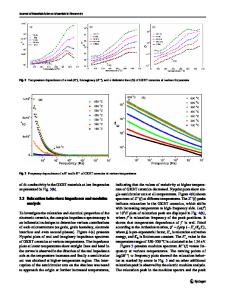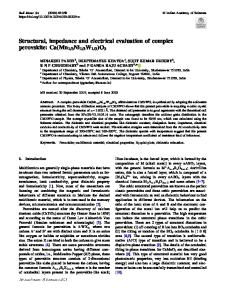Processing, dielectric and electrical characteristics of strontium-modified Ca 1 Cu 3 Ti 4 O 12
- PDF / 2,291,428 Bytes
- 9 Pages / 595.276 x 790.866 pts Page_size
- 84 Downloads / 403 Views
Processing, dielectric and electrical characteristics of strontiummodified Ca1Cu3Ti4O12 Madhusmita Sahu1 · Arijit Mitra2 · R. N. P. Choudhary1 · B. K. Roul3 Received: 15 March 2018 / Accepted: 30 June 2018 © Springer-Verlag GmbH Germany, part of Springer Nature 2018
Abstract In the present paper, the strontium (Sr)-modified Ca1Cu3Ti4O12 ceramic (further termed as CSCTO) has been fabricated by a conventional cost-effective ceramic route. The prepared sample is characterized to obtain the relationship between the structural and electrical properties in a wide frequency (103–106 Hz) and temperature (25–315 °C) ranges. X-ray diffraction spectra depict a single-phase formation of the compound, crystallized in the cubic system. The dielectric relaxation mechanism and electrical properties of CSCTO have been revealed by studying frequency and temperature dependence of dielectric parameters (εr and tanδ) by dielectric and impedance spectroscopy. The temperature-dependant dielectric constant plots depict that at frequency 1 kHz, the compound has very high dielectric constant (order of 1 04) and relatively low tangent loss. The occurrence of ultra high dielectric constant of the compound may be due to the space charge polarization, interface and Maxwell–Wagner dielectric relaxation around low frequencies and high-temperature range. The contributions of grains in resistive and capacitive properties of the material can be obtained from the Nyquist plot. It is interesting to note that at room temperature, polarization loop (P ~ E hysteresis loop) of the sintered CSCTO showed lossy behavior. The use of TiO2 and CuO2 nano-sized powders in the starting stage of sample preparation with micron size of CaCO3 and SrCO3 powder promotes the kinetics of quick conventional solid state reaction at a microscopic level, that favors above possible mechanisms.
1 Introduction Nowadays, energy conversion and its storage are a big problem and challenges for researchers and industries. To solve these problems, the need for energy storage devices is required. For this purpose, modern science and advance technology rely on the development of smart and novel materials, having superior physical properties (i.e., dielectric, electrical, magnetic properties, etc.,) under wide temperature and frequency ranges. In particular, dielectric materials play an important role as a key component in electronic and microelectronic devices, such as capacitor, super-capacitor, resonators, and filters. In this context, Ca1Cu3Ti4O12 (CCTO) is a well known 1:3 A-site-ordered perovskite
* Madhusmita Sahu [email protected] 1
Department of Physics, Siksha O Anusandhan (Deemed to be University), Bhubaneswar, Odisha 751030, India
2
School of Basic Sciences, Indian Institute of Technology, Bhubaneswar, Odisha, India
3
Institute of Materials Science, Bhubaneswar, Odisha, India
exhibiting an extremely high dielectric permittivity. Recent studies show that the magnitude of dielectric permittivity of CCTO is approximately 300,000 in bulk ceramics, 1
Data Loading...











